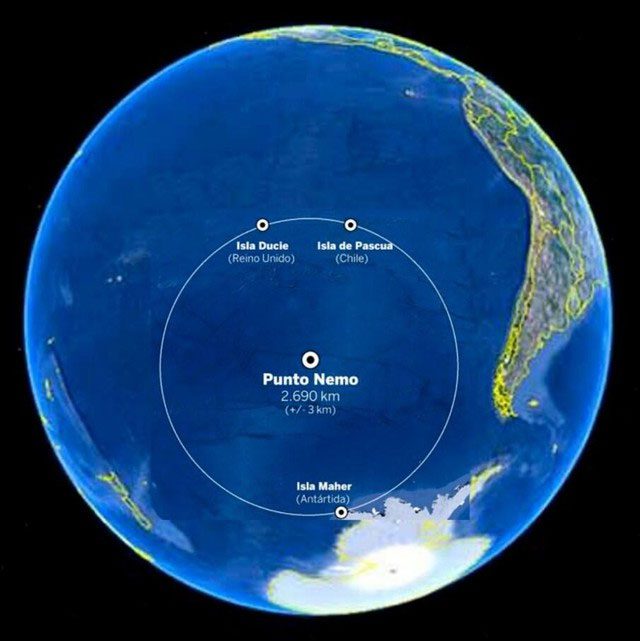This is one of the loudest underwater sounds ever recorded.
Point Nemo in the South Pacific is considered the most remote location on Earth. When ships pass through it, they are 2,689 km away from the nearest land. While the International Space Station flies overhead, the distance between sailors and astronauts on the station is closer than the distance between sailors and land, as they are only 400 km away from their heads.
Due to its isolation and ocean currents, there are very few fish and fishermen in this area, making it a graveyard for old spacecraft. Just like old satellites that have re-entered Earth’s orbit and entered this region, the Soviet/Russian space station Mir ended its “life” at the bottom of the ocean.

Deep in the South Pacific is a point on the Earth’s surface that is farther from land than any other location. Known as Point Nemo, this point is approximately 2,689 km (1,450 nautical miles) away from the nearest land, making it the most remote and isolated place on the planet. If you have ever used the phrase “in the middle of the ocean,” this is also the most accurate phrase to describe Point Nemo.
It was here, in 1997, that the National Oceanic and Atmospheric Administration (NOAA) of the United States discovered a strange ultra-low frequency sound. The sound was detected by hydrophones placed in the Pacific, very powerful and extremely loud, among the loudest underwater sounds ever recorded.
The noise was a mystery, so loud that it was picked up by underwater microphones spaced 4,800 km apart. Some people, including NOAA oceanographer Chris Fox, speculated that these sounds could be produced by a marine animal.
Fox told CNN: “There are a lot of things making noise down there. Whales, dolphins, or some other fish species could be the source of these noises.”

The remote location of Point Nemo makes it an ideal site for space debris to land safely. In fact, this site is so remote that it has been designated by the international space community as a “spacecraft graveyard.” Satellites and other space debris that fall out of orbit often head toward Point Nemo to crash into the ocean safely without harming any populated areas. This is quite useful since spacecraft that are about to fall never land at a specific point and break into thousands of pieces as they enter the atmosphere; the debris fall area can be tens of miles wide and thousands of miles long.
In fact, no known animal is capable of producing such sounds, leading to speculation that it could be a giant squid or some other unknown sea monster. However, at that time, Fox also offered another explanation that seemed more plausible.
“I think it could be related to ice breaking into large icebergs, or large icebergs scraping the ocean floor,” Fox added. “It always comes from the south. We suspect it is ice from the Antarctic.”

Although considered the most isolated location on Earth, Point Nemo still attracts a number of daring tourists willing to make the journey to this remote site. It is worth noting that visiting Point Nemo is not an easy feat, as it requires a long and expensive trip through some of the roughest seas on Earth. The journey is usually undertaken by scientific expedition teams interested in studying the unique ocean currents and dynamics of the area.
NOAA has also detected sounds similar to the previous bloop and even used them to track the A53a iceberg as it broke apart.
The Pacific Marine Environmental Laboratory explained: “The broadband sound recorded in the summer of 1997 corresponds with earthquakes caused by icebergs when they crack and break.”
“The earthquakes had amplitudes sufficient to be detected on many sensors over a range of more than 5,000 km. Based on the azimuth direction, the icebergs that produced the bloop are likely located between the Bransfield Strait and the Ross Sea, or possibly at Cape Adare.”

Point Nemo is located right in the middle of the South Pacific Gyre, a large system of ocean currents circulating clockwise around a central point in the ocean. Because it is so far from land, there is virtually no dust or flow from the mainland, resulting in extremely low nutrient concentrations in the water. This makes the vast area surrounding Point Nemo a gigantic ocean desert. There are no sharks or large fish. Phytoplankton, the tiny algae that form the base of the marine food chain, are only found at depths greater than a hundred meters. But despite the remoteness and lack of large marine life, the South Pacific Gyre still contains many bacteria and other microorganisms, making significant contributions to global biogeochemical cycles. Small crabs have also been found near the underwater volcano close to Point Nemo.


















































